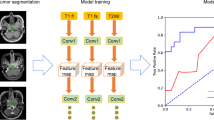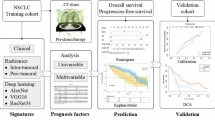Abstract
Purpose
How to discriminate different risks of recurrent nasopharyngeal carcinoma (rNPC) patients and guide individual treatment has become of great importance. This study aimed to explore the associations between deep learning signatures and biological functions as well as survival in (rNPC) patients.
Methods
A total of 420 rNPC patients with PET/CT imaging and follow-up of overall survival (OS) were retrospectively enrolled. All patients were randomly divided into a training set (n = 269) and test set (n = 151) with a 6:4 ratio. We constructed multi-modality deep learning signatures from PET and CT images with a light-weighted deep convolutional neural network EfficienetNet-lite0 and survival loss DeepSurvLoss. An integrated nomogram was constructed incorporating clinical factors and deep learning signatures from PET/CT. Clinical nomogram and single-modality deep learning nomograms were also built for comparison. Furthermore, the association between biological functions and survival risks generated from an integrated nomogram was analyzed by RNA sequencing (RNA-seq).
Results
The C-index of the integrated nomogram incorporating age, rT-stage, and deep learning PET/CT signature was 0.741 (95% CI: 0.688–0.794) in the training set and 0.732 (95% CI: 0.679–0.785) in the test set. The nomogram stratified patients into two groups with high risk and low risk in both the training set and test set with hazard ratios (HR) of 4.56 (95% CI: 2.80–7.42, p < 0.001) and 4.05 (95% CI: 2.21–7.43, p < 0.001), respectively. The C-index of the integrated nomogram was significantly higher than the clinical nomogram and single-modality nomograms. When stratified by sex, N-stage, or EBV DNA, risk prediction of our integrated nomogram was valid in all patient subgroups. Further subgroup analysis showed that patients with a low-risk could benefit from surgery and re-irradiation, while there was no difference in survival rates between patients treated by chemotherapy in the high-risk and low-risk groups. RNA sequencing (RNA-seq) of data further explored the mechanism of high- and low-risk patients from the genetic and molecular level.
Conclusion
Our study demonstrated that PET/CT-based deep learning signatures showed satisfactory prognostic predictive performance in rNPC patients. The nomogram incorporating deep learning signatures successfully divided patients into different risks and had great potential to guide individual treatment: patients with a low-risk were supposed to be treated with surgery and re-irradiation, while for high-risk patients, the application of palliative chemotherapy may be sufficient.





Similar content being viewed by others
References
Bray F, Ferlay J, Soerjomataram I, Siegel RL, Torre LA, Jemal A. Global cancer statistics 2018: GLOBOCAN estimates of incidence and mortality worldwide for 36 cancers in 185 countries. CA Cancer J Clin. 2018;68:394–424.
Lee AWM, Ma BBY, Ng WT, Chan ATC. Management of nasopharyngeal carcinoma: current practice and future perspective. J Clin Oncol. 2015;33:3356–64.
Ng WT, Soong YL, Ahn YC, AlHussain H, Choi HCW, Corry J, et al. International recommendations on reirradiation by intensity modulated radiation therapy for locally recurrent nasopharyngeal carcinoma. Int J Radiat Oncol Biol Phys. 2021;110:682–95.
Liu L-T, Chen Q-Y, Tang L-Q, Zhang L, Guo S-S, Guo L, et al. With or without reirradiation in advanced local recurrent nasopharyngeal carcinoma: a case-control study. BMC Cancer. 2016;16:774.
Sun X-S, Liang Y-J, Jia G-D, Liu S-L, Liu L-T, Guo S-S, et al. Establishment of a prognostic nomogram to identify optimal candidates for local treatment among patients with local recurrent nasopharyngeal carcinoma. Oral Oncol. 2020;106:104711.
Han F, Zhao C, Huang S-M, Lu L-X, Huang Y, Deng X-W, et al. Long-term outcomes and prognostic factors of re-irradiation for locally recurrent nasopharyngeal carcinoma using intensity-modulated radiotherapy. Clin Oncol. 2012;24:569–76.
Bruixola G, Remacha E, Jiménez-Pastor A, Dualde D, Viala A, Montón JV, et al. Radiomics and radiogenomics in head and neck squamous cell carcinoma: potential contribution to patient management and challenges. Cancer Treat Rev. 2021;99:102263.
Beig N, Singh S, Bera K, Prasanna P, Singh G, Chen J, et al. Sexually dimorphic radiogenomic models identify distinct imaging and biological pathways that are prognostic of overall survival in glioblastoma. Neuro-Oncol. 2021;23:251–63.
Dong D, Zhang F, Zhong L-Z, Fang M-J, Huang C-L, Yao J-J, et al. Development and validation of a novel MR imaging predictor of response to induction chemotherapy in locoregionally advanced nasopharyngeal cancer: a randomized controlled trial substudy (NCT01245959). BMC Med. 2019;17:190.
Zhang B, Tian J, Dong D, Gu D, Dong Y, Zhang L, et al. Radiomics features of multiparametric MRI as novel prognostic factors in advanced nasopharyngeal carcinoma. Clin Cancer Res. 2017;23:4259–69.
Zhang F, Zhong L-Z, Zhao X, Dong D, Yao J-J, Wang S-Y, et al. A deep-learning-based prognostic nomogram integrating microscopic digital pathology and macroscopic magnetic resonance images in nasopharyngeal carcinoma: a multi-cohort study. Ther Adv Med Oncol. 2020;12:1758835920971416.
Zhang L, Zhou H, Gu D, Tian J, Zhang B, Dong D, et al. Radiomic nomogram: pretreatment evaluation of local recurrence in nasopharyngeal carcinoma based on MR imaging. J Cancer. 2019;10:4217–25.
Peng H, Dong D, Fang M-J, Li L, Tang L-L, Chen L, et al. Prognostic value of deep learning PET/CT-based radiomics: potential role for future individual induction chemotherapy in advanced nasopharyngeal carcinoma. Clin Cancer Res. 2019;25:4271–9.
Zhong L, Dong D, Fang X, Zhang F, Zhang N, Zhang L, et al. A deep learning-based radiomic nomogram for prognosis and treatment decision in advanced nasopharyngeal carcinoma: a multicentre study. EBioMedicine. 2021;70:103522.
Kirienko M, Sollini M, Corbetta M, Voulaz E, Gozzi N, Interlenghi M, et al. Radiomics and gene expression profile to characterise the disease and predict outcome in patients with lung cancer. Eur J Nucl Med Mol Imaging. 2021;48:3643–55.
Zinn PO, Singh SK, Kotrotsou A, Hassan I, Thomas G, Luedi MM, et al. A coclinical radiogenomic validation study: conserved magnetic resonance radiomic appearance of periostin-expressing glioblastoma in patients and xenograft models. Clin Cancer Res. 2018;24:6288–99.
Fan M, Xia P, Clarke R, Wang Y, Li L. Radiogenomic signatures reveal multiscale intratumour heterogeneity associated with biological functions and survival in breast cancer. Nat Commun. 2020;11:4861.
Dong D, Fang M-J, Tang L, Shan X-H, Gao J-B, Giganti F, et al. Deep learning radiomic nomogram can predict the number of lymph node metastasis in locally advanced gastric cancer: an international multicenter study. Ann Oncol. 2020;31:912–20.
Dong D, Tang L, Li Z-Y, Fang M-J, Gao J-B, Shan X-H, et al. Development and validation of an individualized nomogram to identify occult peritoneal metastasis in patients with advanced gastric cancer. Ann Oncol. 2019;30:431–8.
Wen Y-H, Wen W-P, Chen H-X, Li J, Zeng Y-H, Xu G. Endoscopic nasopharyngectomy for salvage in nasopharyngeal carcinoma: a novel anatomic orientation. Laryngoscope. 2010;120:1298–302.
Tan M, Le QV. Efficientnet: rethinking model scaling for convolutional neural networks. In: ICML. 2019. pp. 6105–14.
Katzman JL, Shaham U, Cloninger A, Bates J, Jiang T, Kluger Y. DeepSurv: personalized treatment recommender system using a Cox proportional hazards deep neural network. BMC Med Res Methodol. 2018;18:24.
Friemel J, Rechsteiner M, Frick L, Böhm F, Struckmann K, Egger M, et al. Intratumor heterogeneity in hepatocellular carcinoma. Clin Cancer Res. 2015;21:1951–61.
Yang F, Wang Y, Li Q, Cao L, Sun Z, Jin J, et al. Intratumor heterogeneity predicts metastasis of triple-negative breast cancer. Carcinogenesis. 2017;38:900–9.
Huang Y-Q, Liang C-H, He L, Tian J, Liang C-S, Chen X, et al. Development and validation of a radiomics nomogram for preoperative prediction of lymph node metastasis in colorectal cancer. J Clin Oncol. 2016;34:2157–64.
Leung S, Zee B, Ma BB, Hui EP, Mo F, Lai M, et al. Plasma Epstein-Barr viral deoxyribonucleic acid quantitation complements tumor-node-metastasis staging prognostication in nasopharyngeal carcinoma. J Clin Oncol. 2006;24:5414–8.
Tang L-Q, Chen Q-Y, Fan W, Liu H, Zhang L, Guo L, et al. Prospective study of tailoring whole-body dual-modality [18F]fluorodeoxyglucose positron emission tomography/computed tomography with plasma Epstein-Barr virus DNA for detecting distant metastasis in endemic nasopharyngeal carcinoma at initial staging. J Clin Oncol. 2013;31:2861–9.
Guo R, Tang L-L, Mao Y-P, Du X-J, Chen L, Zhang Z-C, et al. Proposed modifications and incorporation of plasma Epstein-Barr virus DNA improve the TNM staging system for Epstein-Barr virus-related nasopharyngeal carcinoma. Cancer. 2019;125:79–89.
Leung S-F, Lo YMD, Chan ATC, To K-F, To E, Chan LYS, et al. Disparity of sensitivities in detection of radiation-naïve and postirradiation recurrent nasopharyngeal carcinoma of the undifferentiated type by quantitative analysis of circulating Epstein-Barr virus DNA1,2. Clin Cancer Res. 2003;9:3431–4.
Nie P, Yang G, Wang N, Yan L, Miao W, Duan Y, et al. Additional value of metabolic parameters to PET/CT-based radiomics nomogram in predicting lymphovascular invasion and outcome in lung adenocarcinoma. Eur J Nucl Med Mol Imaging. 2021;48:217–30.
Acknowledgements
The authors thank Prof. Xuebin Xie from KiangWu Hospital, Macau, China for his great help about the clinical part in this paper.
Funding
This work was supported by the Strategic Priority Research Program of Chinese Academy of Sciences (XDB38040200), National Key R&D Program of China (2017YFA0205200, 2017YFC0908500, 2017YFC1309003), National Natural Science Foundation of China (82022036, 91959130, 81971776, 81771924, 62027901, 81930053, 81425018, 81672868, 81802775, 82073003, 82002852, 82003267, 81803105), the Beijing Natural Science Foundation (L182061), the Youth Innovation Promotion Association CAS (Y2021049, 2017175), the Sci-Tech Project Foundation of Guangzhou City (201707020039), the Sun Yat-sen University Clinical Research 5010 Program (2016010, 201315, 2015021, 2017010, 2016013, 2019023), Innovative research team of high-level local universities in Shanghai (SSMU-ZLCX20180500), the Natural Science Foundation of Guangdong Province (2017A030312003, 2018A0303131004), the Natural Science Foundation of Guangdong Province for Distinguished Young Scholar (2018B030306001), the Health & Medical Collaborative Innovation Project of Guangzhou City (No. 201803040003), Pearl River S&T Nova Program of Guangzhou (201806010135), the Planned Science and Technology Project of Guangdong Province (2019B020230002), Natural Science Foundation of Guangdong Province (2017A030312003), the Key Youth Teacher Cultivating Program of Sun Yat-sen University (20ykzd24), and the Fundamental Research Funds for the Central Universities.
Author information
Authors and Affiliations
Corresponding authors
Ethics declarations
Ethics approval
All procedures performed in the study and involving human participants were carried out in accordance with the ethical standards of the institutional and/or national research committee and with the principles of the 1964 Declaration of Helsinki and its later amendments or comparable ethical standards.
Consent to participate
The ethical review board of each participating center approved this retrospective study and waived the requirement of informed consent.
Conflict of interest
The authors declare no competing interests.
Additional information
Publisher’s note
Springer Nature remains neutral with regard to jurisdictional claims in published maps and institutional affiliations.
This article is part of the Topical Collection on Oncology—Head and Neck.
Supplementary Information
Below is the link to the electronic supplementary material.
Rights and permissions
About this article
Cite this article
Zhao, X., Liang, YJ., Zhang, X. et al. Deep learning signatures reveal multiscale intratumor heterogeneity associated with biological functions and survival in recurrent nasopharyngeal carcinoma. Eur J Nucl Med Mol Imaging 49, 2972–2982 (2022). https://doi.org/10.1007/s00259-022-05793-x
Received:
Accepted:
Published:
Issue Date:
DOI: https://doi.org/10.1007/s00259-022-05793-x




